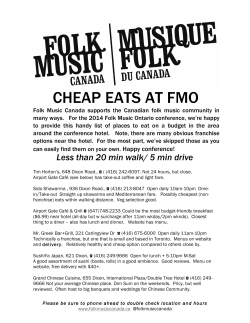
Restoration of Unknown Maker Folk Fiddle Performed by Ron Cook
Restoration of Unknown Maker Folk Fiddle Performed by Ron Cook 1999 For Norma Barnett, Baker City, Oregon Background This violin belongs to my cousin, Norma Barnett, of Baker City, Oregon. It came into our grandfather’s possession sometime in the 1920s. It is unlabeled and unmarked but was probably built by a local craftsman somewhere in the Northeastern region of Oregon. Valuation Handmade folk fiddles are probably the least sought after violins by collectors and musicians. However, folk art collectors might consider paying premium prices for such an instrument. This particular instrument is very well finished on the outside, but roughly hewn and splintery on the inside, like it was whittled into shape. Upon completion of the restoration, I found the instrument to have a very pleasant tone capable of good, but not loud, volume. A musician would probably not pay more than $200$300, but a folk art collector might pay up to $500 for such an instrument. - Page 2 - Assessment & Inventory When Norma sent me this violin, it was in pieces. As you can see, the fingerboard was off, the neck was loose, and all glue joints on the body had failed. The bookmatched back joint was partially open, and the top had numerous cracks and chips. Fortunately, several of the chipped out pieces were saved. - Page 3 - Restoration 1 In the top photo you can see two of the cracks and the chipped edge on the lower bout. The crack going down from the f-hole was bad, but the one down the middle joint was worse. Someone attempted to “fix” the center crack, maybe 30-50 years ago by filling the crack with some kind of grey epoxy, which, of course, dripped all over the inside of the instrument. It was as hard as iron, and scrapping it off took quite a bit of wood with it. The tape on the top was holding the saved piece that chipped of the top side. I didn’t have to work hard to remove the neck. I basically popped right out. The neck had a large crack running the whole length and through the peghead. I had to wedge it open to clean out the gunk that had built up over the years before glueing. I used a fine pointed glue injector to put Titebond glue into the neck crack and clampled it. - Page 4 - Restoration 2 I removed the top by running a warm palette knife around the joint to disolve any remaining hide glue that still stuck the top in place. When I first received the violin I noticed quite a bit of rattling inside when I moved it around. I expected to find pieces of the instrument in there, but to my surprise, there were to rattlesnake rattles (bottom picture). I guess they might have been put in to add a sympathetic “buzzing” sound when played. I put them back in after I finished the restoration. The soundpost was also loose inside. This is a crudely whittled little piece, and I put it back after finishing the repairs. The inside of the top was also crudely whittled (or carved with a dull chisel) and unsanded. All the grain was raised like short fur. - Page 5 - Completion This is the finished product. I used dry pigments to match the original colors as closely as possible. I also had to replace several pieces of purfling, which looked like they had been missing a long time due to the amount of dirt in the cavities. When I strung this up for the first time, I was struck by how loud, clear, and sweet it sounded. This is a beautiful example of a well-made folk instrument. - Page 6 -
© Copyright 2025





















